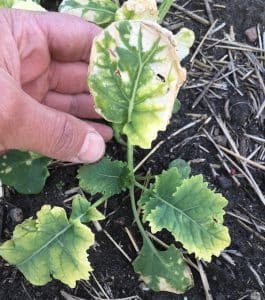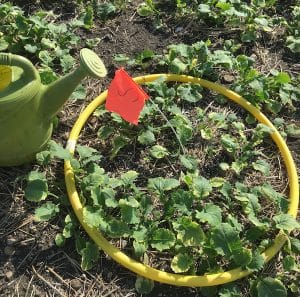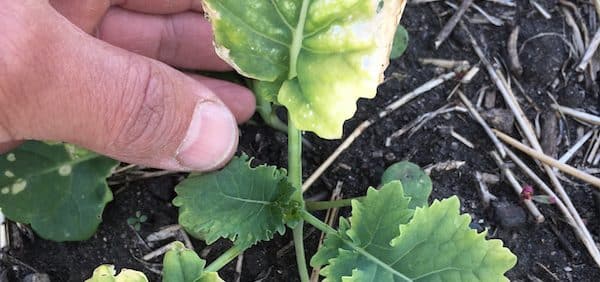Canola Council of Canada agronomy specialists get calls each year from growers or other agronomists who see symptoms and don’t know the cause. One example from the past week was mottling or yellowing of leaf edges in combination with cupping. This was observed in many areas of the Prairies.

Cupping is a symptom of sulphur deficiency, herbicide damage and cold stress. Another possibility is manganese toxicity, which can occur in low pH soils with high levels of manganese.
Before spending money on a treatment, growers will need to identify the cause. The Canola Diagnostic Tool can help you work through the possibilities. A few localized tests can also help with the diagnosis.
For example:
1. To test for sulphur deficiency, apply ammonium sulphate to a small area. Mark off the area, perhaps using a hula hoop. If using dry 21-0-0-24, a rate of 10.9 g/m2 approximates a rate of 20 lb./ac. of actual S. If the hoop is 0.25m2, you would only need 2.7 g. Soak it in with about 10 litres of water per square metre, which mimics a 1cm rainfall. Check again in a week to 10 days to compare plants inside and outside the hoop. Look at the whole plant, including root development, to see if symptoms are increasing or getting better. If the treatment shows a clear benefit, there is still time to apply an S top up across the whole field. (This same test can be used for other nutrients. In fact, you may want to try a few of these square-metre tests with different nutrients applied to each.)

2. Tissue tests can identify nutrient levels inside the plant, including manganese toxicity. A number of labs offer tissue tests. Click here for our labs list. Make sure to ask the lab for sampling protocols.
3. Run a quick soil pH test in affected and unaffected areas. These tests are available from garden stores for a few dollars each. Very low pH in combination with high manganese levels could support possibility for manganese toxicity.
These localized tests provide an opportunity to check on a few potential causes with minimal investment in inputs, while also giving time to see how the crop recovers on its own. Excess moisture, for example, can impede normal nutrient uptake. Soil nutrient levels may be adequate but roots cannot work properly in saturated soil. Once the soil dries down, normal root function returns and new growth shows no symptoms.
More on manganese toxicity. One field showing symptoms was near Kindersley, Saskatchewan. The problem area had a soil pH of 5.2 and tissue test manganese levels of 1,700 ppm. These are extreme levels that do create the potential for manganese toxicity. If manganese toxicity is the cause, new growth isn’t going to be any better. This situation has likely been building for some time, perhaps with pH driven down by high fertilizer applications and manganese driven up by excessive micronutrient combinations. A spot liming may be required to increase the pH and improve productivity of these areas in following years. A complicating factor is that these symptoms seemed to have come on after a significant rain event. If they are primarily driven by the change in root function due to excess moisture, a return to drier soil conditions may help.

